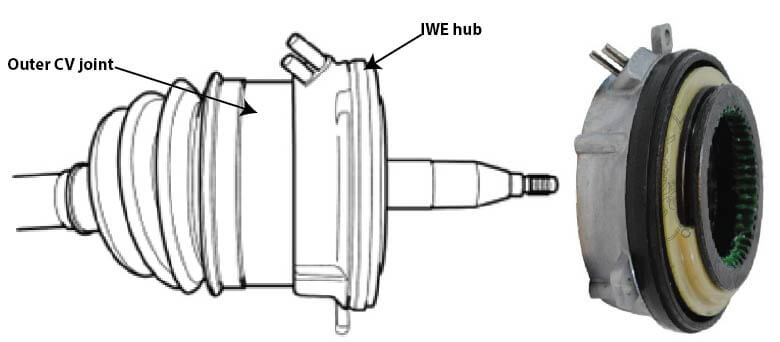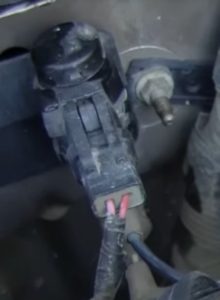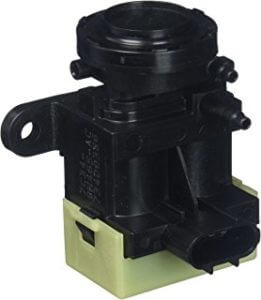Grinding noise on F150
Diagnose and fix grinding noise F150
What causes grinding noise F150
The 2004-06 F150 and Mark LT trucks use a vacuum operated hub connect device called an integrated wheel end (IWE). Ford has experienced issues with the IWE that result in grinding noise F150. Ford has also issued a service bulletin 06-8-15 to address some of the problems associated with water ingestion into the IWE. Ford has redesigned the IWE.
How the IWE system works
These trucks are built with the Borg-Warner 44-06 transfer case, providing 2H, 4H and 4L. When you shift into any of the 4WD modes, an electromagnetic clutch in the transfer case energizes to synchronize the front and rear output shafts. Once up to speed, the system energizes a vacuum IWE solenoid routing vacuum to the IWE spring loaded vacuum operated hubs located on the outer CV joint.

Ford IWE Hub and CV
The IWE system consists of a vacuum reservoir, IWE vacuum solenoid, IWE hubs, vacuum hoses and a check valve. The IWE hubs engage the front wheel hubs to the front axle shafts or disengage them when the 4WD mode is turned off.
The IWE vacuum solenoid receives vacuum from the vacuum reservoir. In 2WD mode, the IWE solenoid receives a ground path from the PCM, opening the vacuum valve to apply vacuum to the IWE ends. That DISENGAGES the front hubs from the front axle shafts. When the driver choses 4WD mode, the PCM disconnects ground to the IWE solenoid, cutting off the vacuum to the IWE hubs. The IWE hubs are spring loaded and the internal spring forces the IWE hub to connect to the front axle shafts.
What causes the grinding noise F150?
A vacuum leak in the vacuum hoses, reservoir or IWE solenoid can cause partial vacuum application to the IWE hubs, causing them to PARTIALLY engage. Since there’s some vacuum at the IWE, the hubs are neither fully on or off, causing the grinding noise.
Diagnose grinding noise F150
The IWE solenoid is located on the passenger side of the vehicle,

IWE solenoid on passenger firewall
under the hood on the firewall. Remove the manifold vacuum line from the solenoid and verify full manifold vacuum is present by using a vacuum gauge (engine running). If you see full manifold vacuum, that verifies the integrity of the vacuum line from the manifold to the IWE solenoid when the engine is running. However, since there’s a vacuum reservoir between the manifold and IWE solenoid, you must also check the leakdown rate once the engine is turned off.
Leave the vacuum gauge in place and shut off the engine. The vacuum gauge should show a slow deterioration of vacuum. If the vacuum drops quickly, service the vacuum lines, vacuum reservoir or the vacuum check valve between the manifold and IWE solenoid valve.
Next, check the electrical portion of the system. The IWE solenoid receives power on the pink/light blue wire from fuse 11 in the fuse box when the key is in the ON position. If you see full battery voltage with the key ON, check for good ground from the PCM on the red wire when the vehicle is in 2WD mode. If you see battery voltage and ground, check for manifold vacuum on the vacuum line that runs to the IWE hubs. That will confirm the solenoid is operating properly.
Next, check the operation of the IWE hubs by using a handheld vacuum pump. Connect the vacuum pump to the vacuum line running from the IWE solenoid to the IWE hubs. Pump up the vacuum and see if the vacuum holds while rotating the front wheels. The vacuum should not drop more than 1-in/minute. If vacuum drops faster than that, check for a vacuum line leak or a leaking IWE hub.
Ford TSB 06-8-15
The Ford service bulletin #06-8-15 addresses a problem with water infiltration into the IWE solenoid that causes the system to fail. The water comes from the cowling area and drips on the IWE solenoid causing it to short out, which can set C1879 and C1980 trouble codes. In addition, the 4H light will be inoperative. Ford has updated the IWE solenoid to solve the problem.
Remove the vacuum lines at the IWE hubs and check for water. If you find water, allow it to drain and blow out the lines using compressed air. Test the vacuum reservoir and check valve to ensure they are dry and working properly.
Replace the IWE solenoid with a new design, part number 6L3Z-9E441-A.

Revised IWE solenoid valve. Ford part 6L3Z-9E441-A
The new IWE comes with a new mounting bracket. Remove the old IWE solenoid and install the bracket, IWE solenoid, connector and vacuum lines.
©, 2018 Rick Muscoplat
Posted on by Rick Muscoplat
